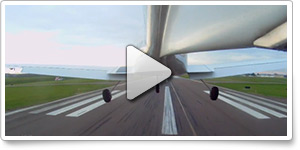| ||||||
| Mushing, then rushing |
| |||||
Training TipsMushing, then rushing Recovery from such a stealthy stall can be made more complicated, as occasional accident reports show, if the pilot rushes through the steps or doesn't clearly understand what must be done, and why. The particulars vary by aircraft, but in a typical trainer's stall recovery, the first step is to lower the angle of attack (AOA) to regain smooth flow of air over control surfaces, bringing back control responsiveness. Next, “maximum allowable” power is added, and wings are leveled. In training or on a practical test, completion of the maneuver involves resuming straight-and-level flight “with a minimum loss of altitude appropriate for the airplane.” When practiced stall recoveries don’t quite measure up, a common cause is failing to give step one—lowering the AOA—enough respect and giving step two—adding power—too much. The result can be a prolonged recovery with excessive altitude loss, or a surprise secondary stall. Reasons for the faulty technique can include anxiety about getting through the maneuver, or an incorrect idea about the role each step plays in the recovery. Remember: It is lowering the AOA, not adding power, that breaks the stall. A way to dispel any misunderstanding about that is to practice recoveries from stalls without using power. Starting at a generously safe entry altitude, perform a clearing turn and a normal stall entry. After lowering the AOA to initiate the recovery, continue to accelerate in the glide until reaching an airspeed at which control is fully regained. Note the pitch attitude, how much time it takes to regain control effectiveness, and altitude lost. Then add power and resume normal cruise flight. Not only will your next conventional stall recovery using power be smoother—and be more instinctive—after some power-off recovery practice, but you also will have acquired a better appreciation of how much altitude loss is avoided when using power as recommended, and perhaps decide that a maneuver you once found stressful is actually fun and a confidence builder. For more insights into angle of attack, see this Webinar from the Air Safety Institute. Flight Training NewsAstronaut prepares next generation of explorersNASA astronaut Nicole P. Stott was one of six on board the final mission for the space shuttle Discovery in February 2011. Her final flight was a highlight, if not the culmination, of a space flight career that launched in many ways at a small Florida airport, riding in her father’s Skybolt. Her current assignment finds her back in Florida as NASA gears up to assist commercial operators preparing for space missions. Read more >> Texas teen continues family aviation traditionFor Robert William “Will” Kembel, flying is a family tradition—a tradition he intends to continue. The 17-year-old from Denton, Texas, recently completed his private pilot certificate in a Piper Cherokee 235. Grandfather Gary Lynch was a test pilot for Bell Helicopter. Grandfather Robert Darrel Kembel is an instrument-rated private pilot, and Will’s father is a private pilot with a glider rating. Will plans to push on with instrument, commercial, and glider training. AirVenture to host mentoring camp for young womenWomen Soar, You Soar, a four-day mentoring camp for young women, will take place July 26 through July 29 at EAA AirVenture in Oshkosh, Wis. The program is available to girls entering grades 9 through 12 in fall 2012, and is intended to introduce them to aviation-based careers. Participants will use flight simulators, assemble wing ribs, and attend workshops and mentor sessions. They’ll also experience attractions taking place during the final weekend of AirVenture. Applications will be accepted through June 29. The $75 participation fee covers lodging at the University of Wisconsin, meals, and admission to AirVenture. For more information or to register, see the website. Between a cloud and a hard placeDon’t take a look-and-see attitude when it comes to weather. Do you have personal weather minimums? If not, develop them now. Think about it: While you’re on the ground, visibility might seem just right, and the ceilings may look like they’re at a comfortable height. But it’s the unexpected, deteriorating weather that catches pilots off guard, sometimes flying them into an unrecoverable situation. Especially critical is the temperature/dew point spread. Learn to interpret the weather by taking the Air Safety Institute’s Weather Wise: Ceiling and Visibility free online course. Training ResourcesWhether you’ve logged thousands of hours or recently began learning to fly, the decision-making and risk-management process can sometimes be arduous. While airline pilots consult company guidelines, general aviation pilots are mostly left to their own judgment for go/no-go decisions. Worried about external pressures fouling your decision? Then take a more formal approach. Plug your profile and expected fight conditions into the Air Safety Institute's ASI Flight Risk Evaluator and let this nifty application suggest the best course of action. Of course, as pilot in command you’re still in charge of the final go/no-go decision.
Did you know that student pilots who join AOPA are three times more likely to complete their flight training? Membership includes unlimited access to aviation information by phone (800/USA-AOPA, weekdays from 8:30 a.m. to 6 p.m. Eastern time) or from Flight Training Online or AOPA Online. If you're not already a member, join today and get the pilot’s edge. Login information is available online. The last six inches Career PilotFltops.com sponsors job fair in Las VegasA global pilot job fair and career conference sponsored by Fltops.com will take place April 13 in Las Vegas, Nev. Employers that are confirmed to attend include AirNet, CAE SimuFlite, Cape Air, Compass Airlines, Emirates Airlines, ExpressJet, GoJet, SkyWest, Southwest, United, and Virgin America. The event is open to Fltops.com members. For more information or to register, see the website. Expanded crew screening program soughtAirlines for America (A4A) and the Air Line Pilots Association (ALPA) announced on Feb. 15 their intent to expand the Known Crewmember program to more U.S. airports in 2012, following a successful test of the risk-based security program at seven hub airports. The test, launched in April 2011, enables TSA officers to verify the identity and employment status of airline pilots, who already undergo thorough criminal background and employment checks as a condition of their employment. The program allows pilots to utilize a more efficient security-screening process; both ALPA and A4A have asked the TSA to include flight attendants in the future. Plane SpotterThe mighty Maule Training ProductsPractical Test Standards eBooks from ASAWant to keep those all-important practical test standards within reach? ASA offers the pertinent PTS for many certificates and ratings in eBook format. For example, you can purchase the Sport Pilot, Private Pilot Airplane (Single-Engine Land), Instrument (Airline, Helicopter, and Powered Lift), or Commercial Pilot (Single or Multiengine Land) PTS. Each is $4.95. For more information, see the website or call 800/272-2359 (800/ASA2FLY).
Note: Products listed have not been evaluated by ePilot editors unless otherwise noted. AOPA assumes no responsibility for products or services listed or for claims or actions by manufacturers or vendors. Member BenefitsThree new discounts add value to AOPA membershipThree more companies have joined the AOPA Lifestyles Member Discounts Program, a free core membership benefit available to all AOPA members. New offers include $10 off any $100 or more online order at Desser Tire and Rubber Co., the world's largest aircraft tire distributor; a 10-percent discount toward the purchase of a new hangar from Worldwide Steel Buildings; and a 10-percent discount on all aviation interior services from Aviation Design. Read more >> AOPA Legal Services Plan not just for violationsBeyond planning ahead for the day you find yourself in trouble with the FAA, there are other reasons to sign up for AOPA’s Legal Services Plan. If you’re in the market to buy an airplane, it can be invaluable. The nearly 700 panel attorneys who participate in AOPA's Legal Services Plan know where the minefields are in the aircraft purchase process, and the plan will provide you with up to one hour with a panel attorney (two hours for Legal Services Plan Plus) to help you avoid them. Read more >> BlogsThe places you'll go: An ice runway in New HampshireIn this week's Flight Training blog, Patrick Collins describes his trip to the nation's only registered ice runway in the new reader-submitted feature, “The places you’ll go.” Also, pro pilot blogger Chip Wright says 2011-2012 has been an easy winter for him. Has it been that way for you? If you see this, you're on final to TahitiHave you been following the adventures of the Slovenian pilot flying around the world in a Pipistrel motorglider? In the Reporting Points blog, AOPA Pilot Senior Editor Al Marsh shows you the breathtaking view that the pilot saw as he landed in Tahiti to investigate engine vibrations and a leaky carburetor. AOPA Career OpportunitiesEver dream of turning your passion for aviation into a career? We’re looking for a manager of regulatory affairs, director of new market development, associate project manager, online product manager, marketing specialist–products, aviation education program developer, accounting manager, and associate editor–Web/ ePilot. To learn more about other AOPA career opportunities, visit AOPA Online. Community
AVIATION EVENTS & WEATHER
| ||||||||||||||||||||||||||||||||||||




 The Feb. 24
The Feb. 24 





